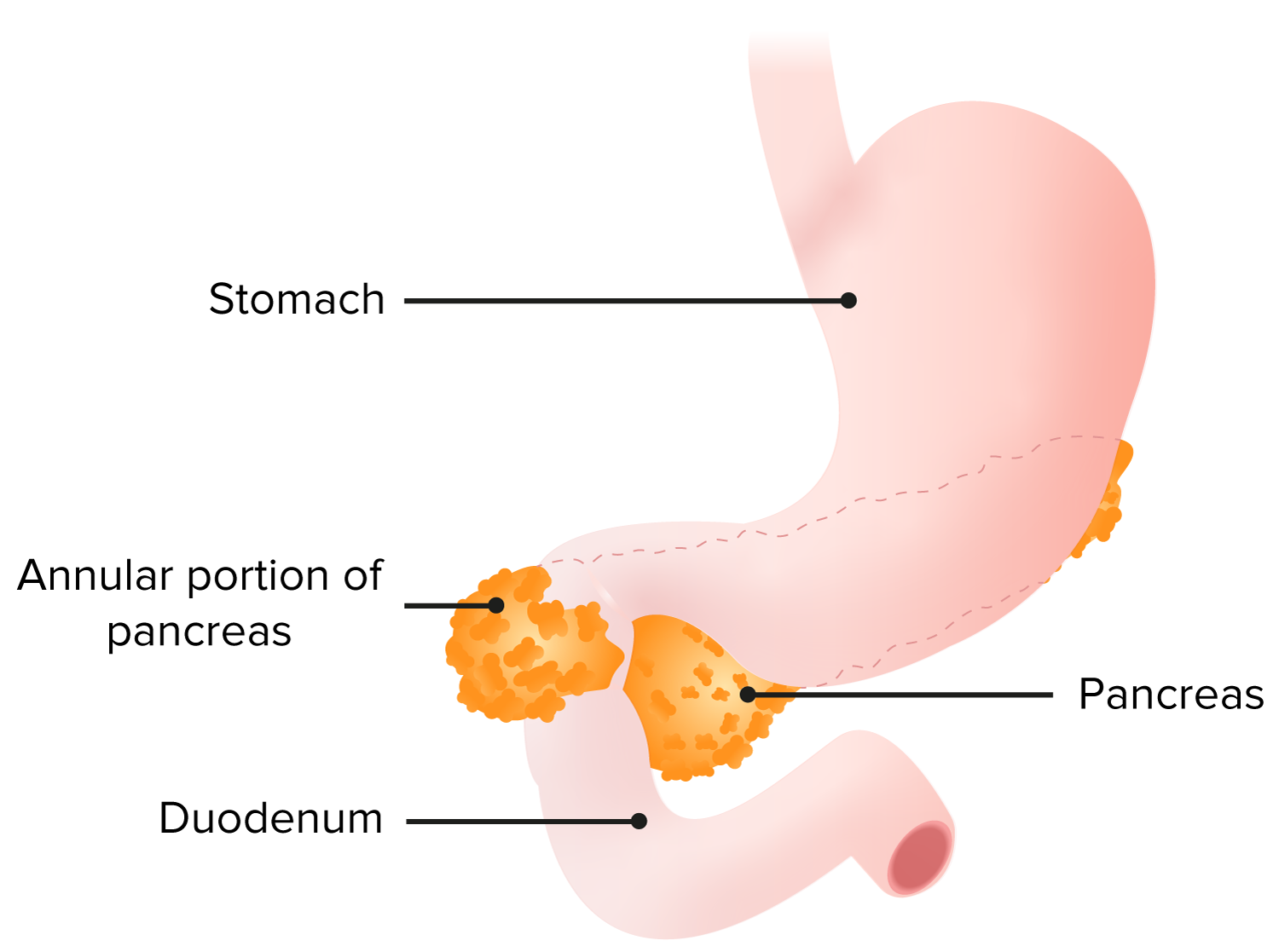Playlist
Show Playlist
Hide Playlist
Duodenal Atresia
-
Slides Stomach and Duodenum.pdf
-
Download Lecture Overview
00:01 Let's take a look at Duodenal atresia. What does the term "atresia" mean? Lack of development. 00:07 "Atresia" means lack of development. Here the duodenum is not developed properly. Why? Oh, it could be genetic, maybe associated with Down Syndrome. So duodenal atresia, Down syndrome. 00:24 On abdominal X-ray, you'd find double bubble sign. D−D−D. Once again, duodenal atresia, Down syndrome, Double bubble. 00:34 Know those. Trisomy 21, Down syndrome. Signs and symptoms. The vomit that you'd find here with duodenal atresia is the fact that now I want you to think normal physio−anatomy. And we have the bile duct. The bile duct is then going to connect to the, with the pancreatic duct will connect to the second part of the duodenum. 01:03 It connects so that you emulsify the lipids so on and so forth but you're in the second part of the duodenum and then you end in a pouch. You're in the second part of the duodenum. The bile duct just connected, okay. 01:17 So you don't have a problem with that but the rest of it doesn't canalize properly. So the failure of recanalization of the two parts of duodenum in which the bile duct is still connecting. When you vomit, what's coming out is going to be yellow and green. Are we clear? So we call this a bilious type of vomit. 01:41 Whereas in physiology and embryology, you'll learn about pyloric stenosis. In that type of vomit, think about the pylorus, it's not even close to the bile duct, right? So therefore, that type of vomit that you find with that first born male with pyloric stenosis would be projectile and they would be non−bilious. 02:04 This would be bilious. Often on first day of life. Usually abdominal distention because of lack of recanalization of your duodenum. And simple, simple concept. For amniotic fluid circulation in utero in which you can get any question in utero when dealing with hydramnios, correct. Listen, womb of a mother, amniotic fluids surrounding the fetus in the placenta, right? This amniotic fluid allows for space for the fetus to develop. Circulation that you want to keep in mind so that you get all clinical questions right for amniotic fluid. The baby, the fetus, in utero swallows the amniotic fluid. Then the amniotic fluid would have passed through the body and the fetus is going to urinate the amniotic fluid "into the placenta". 03:05 Work with me here. If the duodenum doesn't form properly, failure to recanalize, the fetus in utero is going to then vomit "the amniotic fluid back into the placenta". Upon ultrasound, what are you gonna find? Polyhydramnios. What if the trachea and the esophagus are connected? It's called the tracheoesophageal fistula. 03:37 What if the esophagus doesn't form properly, called esophageal atresia. In embroyology, remember, here in utero, the fetus is going to "vomit the amniotic fluid into placenta". In esophageal atresia, what are you going to find on ultrasound on a pregnant lady? Polyhydramnios. 04:00 You understand the simple concept that I've given you for amniotic fluid in utero. The fetus "swallows the amniotic fluid and recycles it constantly". Polyhydramnios, abdominal distention, bilious vomiting, welcome to duodenal atresia. D−D−D. Duodenal atresia, Down Syndrome, double bubble sign. 04:22 On your abdominal x−ray, take a look at the two major areas on your abdominal x−ray. You find black lucent bubble number one, black lucent bubble number two. Double bubble sign. 04:37 Treatment, surgery. It's Atresia.
About the Lecture
The lecture Duodenal Atresia by Carlo Raj, MD is from the course Stomach and Duodenum Diseases: Basic Principles with Carlo Raj.
Included Quiz Questions
Which of the following is NOT formed in a classical case of duodenal atresia?
- Junction of the 1st and 2nd parts of the duodenum
- Junction of the 1st and 2nd parts of the duodenum along with the common bile duct and the pancreatic duct
- Junction of the 1st and 2nd parts of the duodenum along with the common bile duct
- The 1st part of the duodenum along with the common bile duct
- The 1st part of the duodenum
A pregnant patient undergoes a congenital anomaly scan. Results show a fetus with increased intercanthal distance. Fetal karyotyping shows trisomy 21. Which of the following signs is NOT to be expected?
- Oligohydramnios
- Polyhydramnios
- Excessive weight gain in the mother
- Increased pressure on the abdominal aorta causing more blood pressure discrepancy
- Large for the date on clinical examination
Customer reviews
5,0 of 5 stars
| 5 Stars |
|
1 |
| 4 Stars |
|
0 |
| 3 Stars |
|
0 |
| 2 Stars |
|
0 |
| 1 Star |
|
0 |
this topic is well explained and the discussion is clinically correlated. Thanks




